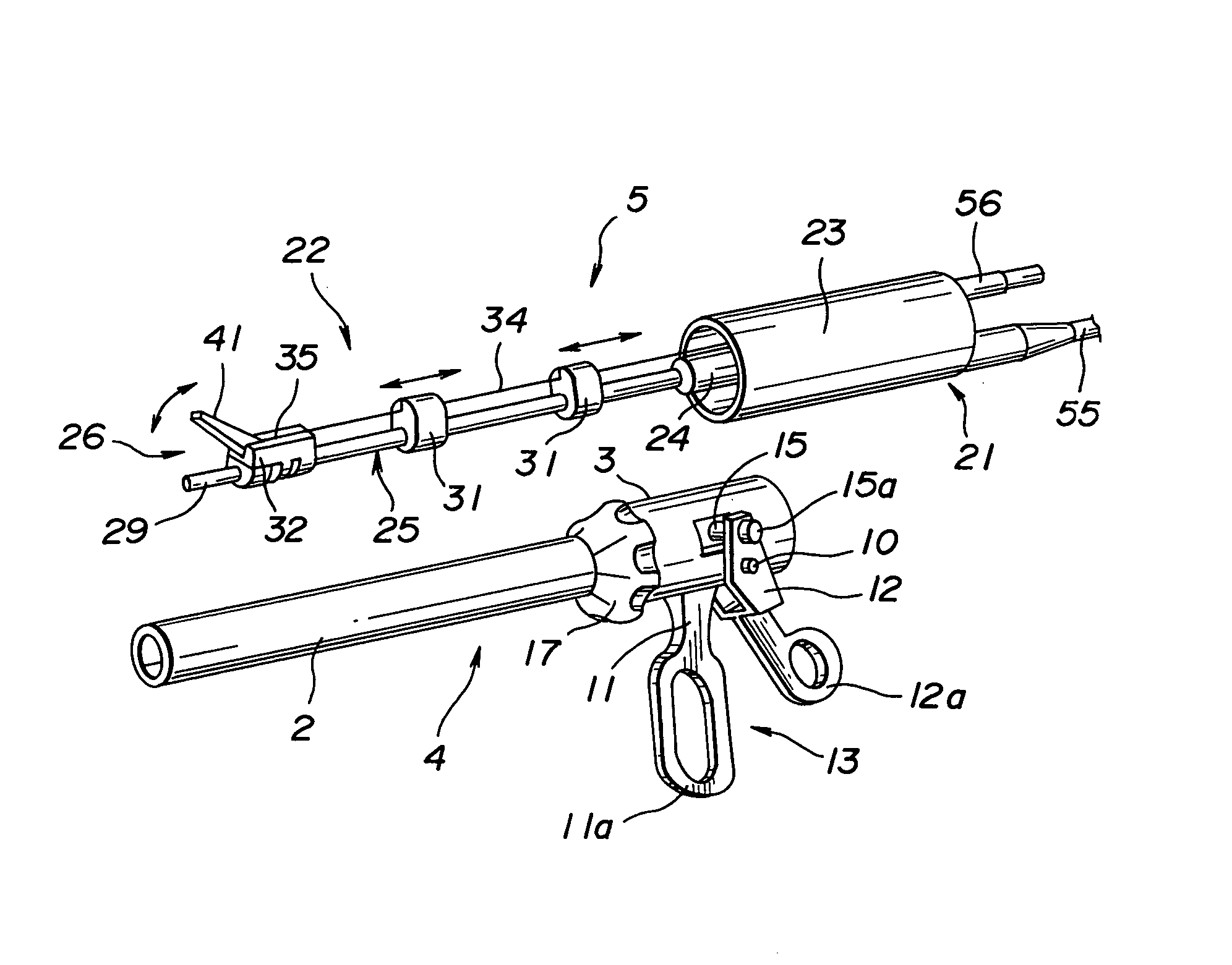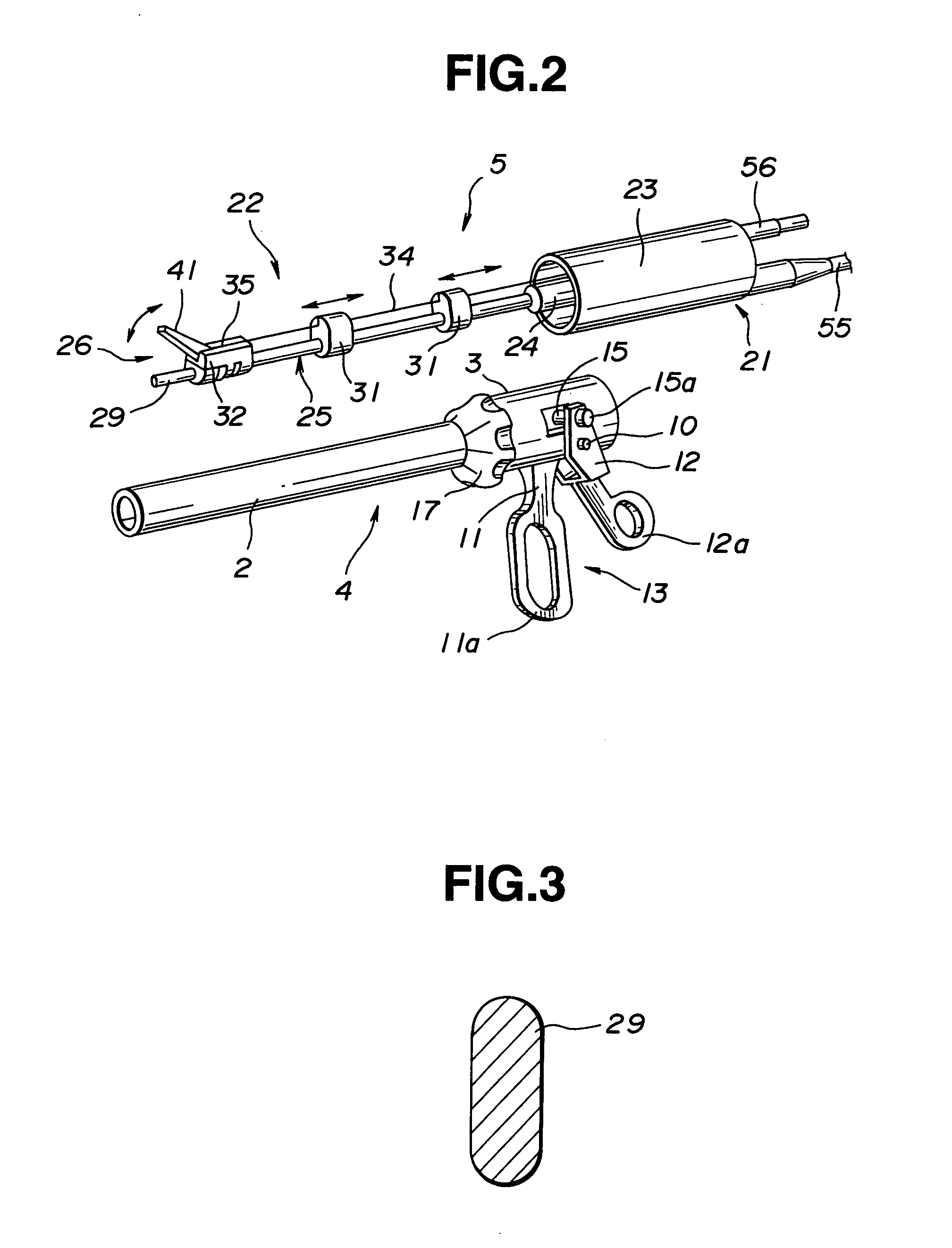Ultrasonic treatment appliance
a treatment appliance and ultrasonic technology, applied in the field of ultrasonic treatment appliances, can solve the problems of living tissue not being able to be clamped reliably, the force exerted to clamp the living tissue weakens, and the probe is therefore likely to deflect, so as to prevent deterioration of resection and coagulation ability, and minimize the occurrence of nois
- Summary
- Abstract
- Description
- Claims
- Application Information
AI Technical Summary
Benefits of technology
Problems solved by technology
Method used
Image
Examples
first embodiment
[0083]Referring to FIGS. 1 to 9, the present invention will be described.
[0084]In this embodiment, an ultrasonic incision / coagulation appliance is taken as an example of an ultrasonic treatment appliance.
[0085]As shown in FIG. 1, an ultrasonic incision / coagulation appliance 1 has a main unit of a handpiece (main unit of a treatment appliance) 4 including an elongated cylindrical sheath 2 that is an insertion unit protecting member and a cylindrical grip sheath 3 located proximally to the sheath 2. A treatment unit 5 is mounted in the main unit 4 so that the treatment unit 5 can be dismounted freely (See FIG. 2).
[0086]The grip sheath 3 includes an operation unit 13 composed of a stationary handle 11 and movable operation handle 12. The stationary handle 11 is fixed to the grip sheath 3, while the movable operation handle 12 is attached to the grip sheath 3 by a pin 10 so that the movable operation handle 12 can pivot freely. The movable operation handle 12 can therefore pivot freely...
second embodiment
[0133]Referring to FIG. 12, the present invention will be described.
[0134]In this embodiment, the structure in which a thin chip is attached to a jaw body is different from that in the first embodiment. The other components of this embodiment and the operation thereof are identical to those of the first embodiment. The same reference numerals are assigned to the same members. The description of the members will be omitted.
[0135]As illustrated, a metallic thin chip 52a is affixed to the bottom of the clamping ditch 51 formed in the jaw body 40, and the proximal portion of the thin chip 52 is fixed to the jaw body 40 using a screw 71. For preventing the head of the screw 71 from jutting toward the clamping side of the jaw body, the proximal portion of the clamping ditch 51 of the jaw body 40 is formed as a recess 72 that is deeper than the thickness of the head of the screw 71. The proximal portion of the thin chip 52 is screwed in this recess 72.
[0136]Since the thin chip 52 is fixed...
third embodiment
[0137]Referring to FIG. 13, the present invention will be described.
[0138]In this embodiment, the structure in which a thin chip is attached to a jaw body is different from those in the first and second embodiments. The other components of this embodiment and the operation thereof are identical to those of the aforesaid embodiments. The same reference numerals are assigned to the same members. The description of the members will be omitted.
[0139]As illustrated, fitting grooves 73 to which the side margins of a thin chip 52b are fitted and fixed are bored on both right-hand and left-hand sides of the bottom of the clamping ditch 51 formed in the jaw body 40. In other words, the width of the thin chip 52b is made larger than the width of the ditch. The side margins of the thin chip 52b are fitted into the fitting grooves 73, whereby the thin chip 52b is attached to the jaw body 40 in order to construct the jaw 41.
[0140]Since the thin chip 52b is thus fixed to the jaw body 40 by fitti...
PUM
 Login to View More
Login to View More Abstract
Description
Claims
Application Information
 Login to View More
Login to View More - R&D
- Intellectual Property
- Life Sciences
- Materials
- Tech Scout
- Unparalleled Data Quality
- Higher Quality Content
- 60% Fewer Hallucinations
Browse by: Latest US Patents, China's latest patents, Technical Efficacy Thesaurus, Application Domain, Technology Topic, Popular Technical Reports.
© 2025 PatSnap. All rights reserved.Legal|Privacy policy|Modern Slavery Act Transparency Statement|Sitemap|About US| Contact US: help@patsnap.com



